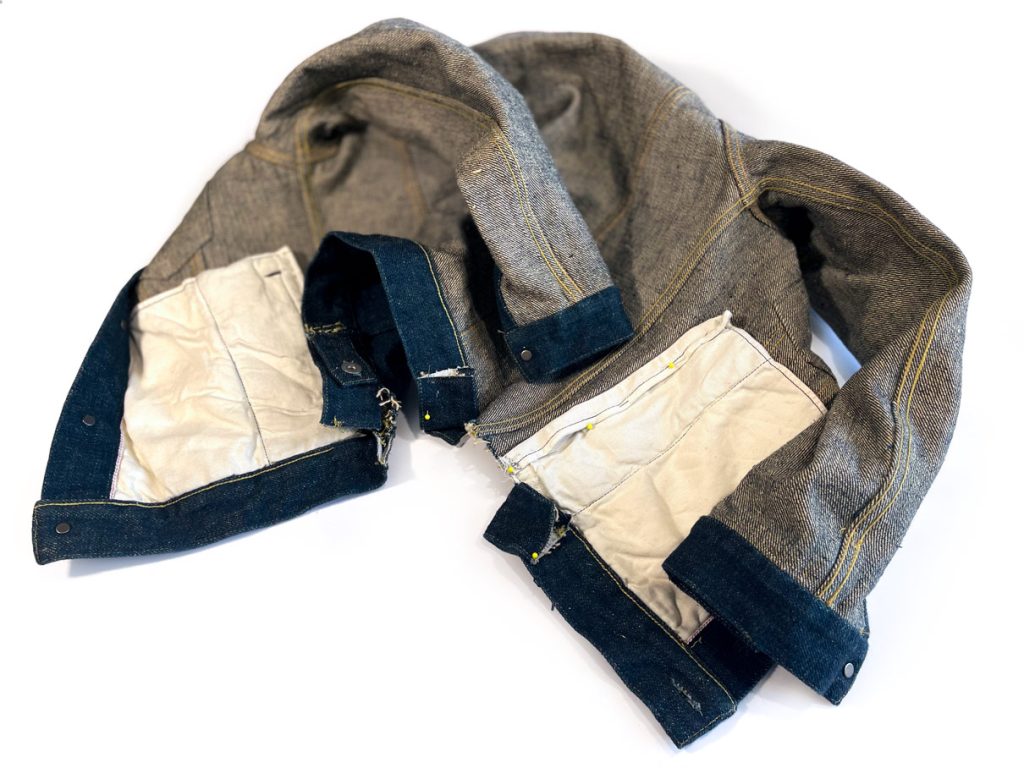
“Can you tailor denim jackets?” is a frequently asked question at Williamsburg Garment Company. Our answer, as with all denim products, is, of course, yes, but jackets and shirts are more complicated. They have armholes and shoulder widths that correspond to the width of the body. When you narrow the body width evenly, the armhole shrinks and the armpit curve is negatively affected. At the same time, the shoulder width remains constant, resulting in wide shoulders compared to the body width. The only way to avoid this is to remove the sleeves and, if possible, draft new armholes and sleeve shapes. Otherwise, you can leave the armhole alone and narrow the body unevenly from the chest/armholes down.
Nothing about modifying denim jackets is simple or easy. The body width is linked to the armhole and shoulders, whereas the sleeve length is linked to the button placket length and/or the armhole.
Can you tailor denim jackets on a home sewing machine?
When it comes to DIY denim jacket alterations, the short answer is that you can do it, but it is not recommended. If you’ve done any research on the subject, you’ve probably discovered that all of the videos and advice you’ve seen have had poor results on cheaply made garments.
Flat-felled seams on the sides, shoulders, and sleeves distinguish traditional jean jackets. This design eliminates the option of doing high-quality alterations on home sewing machines, at your local dry cleaners, or at the best, most reputable tailoring shops. Most denim alterations specialists lack the factory equipment (a Feed-off-the-Arm 3-Needle or Double Chainstitch Industrial Sewing Machine) to duplicate the double-needle flat-felled seam with chain stitching and must come up with an improvised method to sew them.
Most denim jackets and jeans are produced with fabric that is too thick for home machines. To tailor denim on a home sewing machine, you would need to avoid thick seams or deal with really thin, lightweight denim fabrics.
Thread size is also an issue with DIY and most tailoring shops. Denim is typically sewn with thicker thread sizes than most other garments, which contributes to its distinctively sturdy appearance. Home machines are not designed to handle the needle sizes required for thick threads. They also lack the ability to puncture through layers of denim using wide-diameter needles with large eye holes. Thin thread sizes and short stitch lengths are two of the reasons why denim does not look like denim when it is not sewn with the proper threads.
How altering a jean jacket professionally is done
The owner of this heavyweight Oni Denim jacket adored it, however, he had a small frame and required the chest and arms reduced. Here are the steps we used to customize his denim jacket:
1. Chain-stitched flat-felled seams close the sides and sleeves of traditional jean jackets. Because the band at the bottom is chain stitched to the jacket, our first step was to remove the chain stitching connecting the waistband to the body, just enough to remove excess fabric and resew the seams closed.
2. Following that, we split the waistband and removed the chain stitching that held the flat-felled seams together from the waistband to about 6 inches from the cuff seam. After narrowing the excess fabric around the bicep, just past the elbow, we could neatly flow into the sleeve.
3. We press flat the flat-felled seam folds in order to draw the new shape from the waistband up to the armpit and then fade out the shape before reaching the cuff.
4. The seams were then closed (as indicated in the image below) by stitching fresh double-needle chain-stitched flat-felled seams using the same thread size and color as the original. If you look closely at the yellow chain stitching, you can see where the new sewing blends in with the old.

6. After cutting away the extra fabric of the bottom band, we rejoined and resewed it to the body with single-needle chain stitching.
7. Finally, the band tabs along the side seams were reattached. Again, if you look very closely, a seamline where the waistband was split and resewn can be seen near the two yellow stitch lines that attach the tabs. Take note of the new chain stitching that joins the old one below the pocket bag.
Williamsburg Garment Company’s objective is to make alterations to improve fit while retaining the original style and construction. This entails matching thread colors and sizes and stitching seams back the same as the original factory sewing.





